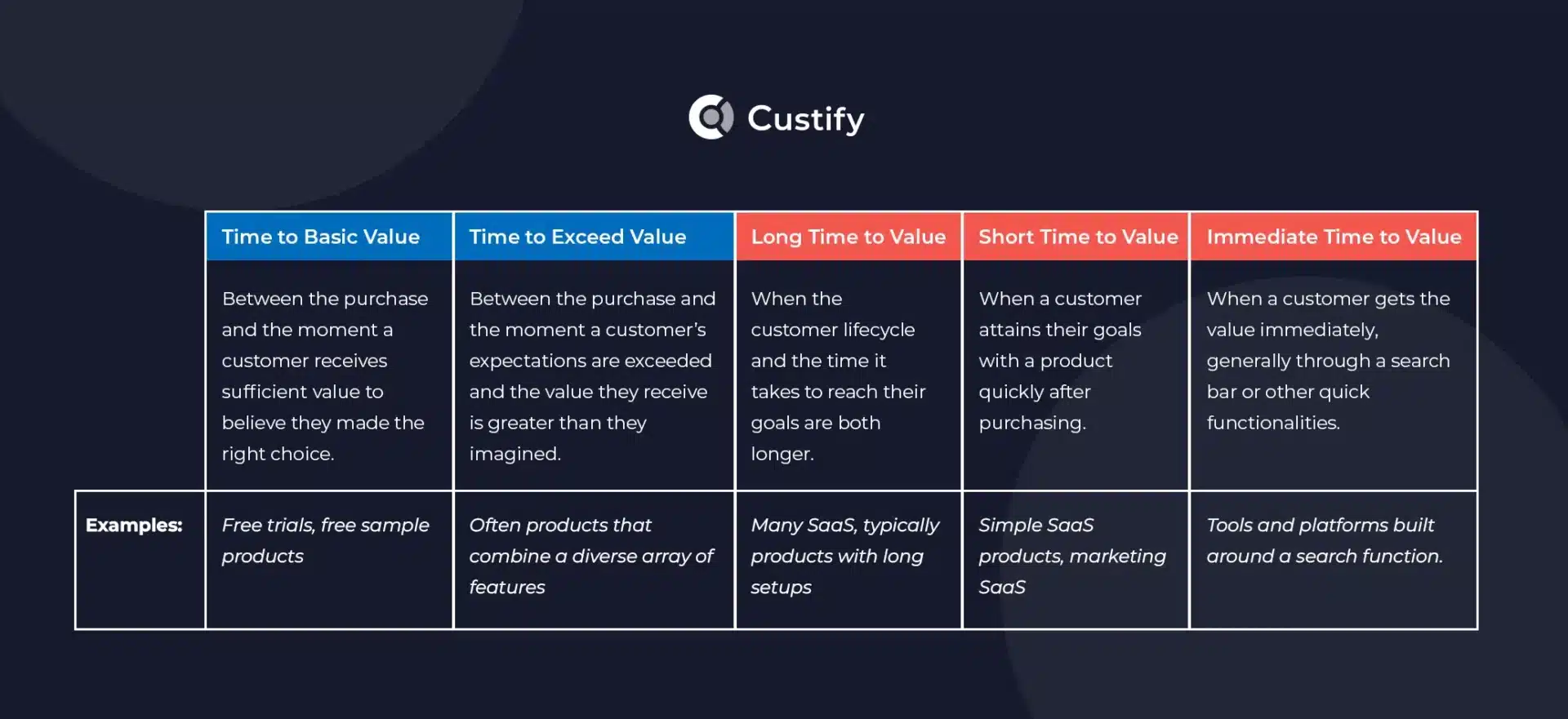One of the worst things to admit in any job is a failure. And failure to attain client goals is even worse. That’s why TTV, or time to value, is a vital metric to track. It provides an accurate snapshot of your product’s effectiveness and keeps you on your toes.
Yet SaaS customer behavior is evolving, and goals can be complex and hard to achieve.

That rise also brings challenges in product, communication, and processes. The road to improving time to value can be tricky, but with a few customer success tactics, it will all become clear very soon.
What Is Time to Value?
Simply put, TTV is the time to value between the moment a purchase is made and when the customer receives value from that purchase.
Any customer-facing business wants to reduce the time to value and improve efficiency. And your onboarding can accelerate time to value. The sooner a customer sees any benefits from a product, the better off everyone will be, and the bigger the chance for the ever-coveted word-of-mouth marketing.
Customers have wildly different goals and expectations for the time it takes to achieve those goals. As such, it’s easier to split TTV into five types:

What Is Time to Value in Customer Success?
SaaS time to value is more about time to basic value, long time to value, and time to exceed value. Focusing on customer relationships and helping them reach and surpass their goals, customer success is very much the team that drives TTV in SaaS.
Most CSMs consider TTV a vital metric concerning their performance. For many, the ultimate metric indicates how well they do their jobs. Let’s look at how CS people use their tried and true tactics to increase TTV:
Improve Time to Value Using Customer Success Tactics
1. Audit Internal Processes for Miscommunication and Churn Precursors
The first step toward helping customers reach their goals is to ensure you’re not detracting from them.
Any SaaS is as good as its internal procedures allow it to be. If your customers suffer as a result of poor internal communication or processes, they’ll quickly move toward the competition. The frustration here is also directly proportional to how much money they spend on your product or service.
So your first step to optimizing TTV should include the following:
- An audit of internal processes, especially in and between customer-facing departments, to remove roadblocks and improve efficiency in delivering value to the customers.
- A review of churn precursors (using your customer success software to track customer behavior), complete with a series of steps to eliminate or mitigate them.
- A plan to improve both internal and customer communication.
2. Optimize Handoffs for Expected Value and Attain Customer Goals
Next, ensure everyone understands the value of properly setting and communicating goals. This might also be an issue on the client’s side, in which case CSMs must express how setting goals can drive value (up to 18%, according to a study by the American Psychological Association).
A frequent TTV detractor is the handoff from sales to success. Clear communication at this stage is crucial to everyone involved, yet it’s also an area with frequent and prominent issues. I explain how to optimize the Sales to CS handover here, but to improve TTV, you should also keep these points top-of-mind:
- Focus on understanding customer goals.
- Note the differences between a customer’s expected product value and their goals with it (sometimes they would like the product to be more than just a goal-buster).
- Sales must involve customer success in a meeting where the goals are discussed.
- Customer success must ask questions about those goals.
- Both Sales and CS must make sure those goals are SMART.

3. Use Tools to Showcase Your Product’s Value
Onboarding for customer success can be the topic of an entire article or guide. Still, today’s point is to make the experience as smooth as possible. This way, you allow for better learning and understanding so new customers attain value as quickly as possible.
Some action points here:
- Product demos must be recorded and sent to customers so they can be reviewed.
- Guided product tours are a great way to ensure customers understand the features they’re buying.
- Use product tour tools when short-staffed to bypass the need for handholding and still showcase your best features.
- Monitor customer activity as much as possible via your CS tool or otherwise, and set alerts to step in when customers can’t figure out product usage or features.
- Leverage the power of generative artificial intelligence to automate support and onboarding processes.
4. Use Proactive Outreach as the Backbone of Your Entire Strategy
Speaking of stepping in, proactive efforts like the one above need to be part of your daily arsenal as a CSM. So when optimizing for time to value, proactive outreach can be the ace up your sleeve.
Find your customers’ preferred channel of communication (generally where they talk to you), and then use it for any of the following scenarios:
- Unsure about a customer’s goal(s)? Reach out and ask them.
- An account metric looks completely off? Reach out and ask the customer.
- Did you launch a new feature? Talk to customers and explain how it might help them in their goals.
- Found a cool article that might help customers? Send it to them.
All these proactive customer engagement tactics and more can significantly improve time to value and turn fresh customers into brand ambassadors.
5. Work with Product Teams and Use Customer Insights to Improve
Beyond all the efforts to improve TTV internally to the CS team, there must be a workable relationship between the product team and customer success.
When it comes to delivering customer goals, nothing has more impact than a collaboration to:
- Analyze customer patterns and optimize the product to help those customers achieve their objectives.
- Work on projects together to increase customer satisfaction and, implicitly, TTV.
- Share customer metrics and have a shared overview of accounts.
- Constantly meet up and discuss new features, tools, or processes to optimize the value delivered to customers.

Imagine the following scenario:
A CSM is on a call with a client, and during their discussion, the client has an idea for a feature that might make their lives 10x easier. Instead of waiting for the monthly product meeting, the CSM can ask a product person to jump on the call or join the next one. A productive internal relationship translates into a productive external one, which is the main point to remember for any effort to improve time to value.
Measure More than Time to Value
Time to value is just one metric in the CSM’s wide array of tools. It’s necessary to have a strategic overview of every account, but sometimes it’s helpful to look beyond and see:
- The messages of customers who thanked you in the last month
- The productive discussions you have in your chats with a customer
- The patterns and ideas you can only find by communicating with clients
And many more insights like this. At the end of the day – even in B2B SaaS – it’s about the people you’re helping and the lives you’re affecting. And that’s the biggest value you can provide.

Philipp Wolf, CEO of Custify
About the Author:
As the CEO of Custify, Philipp Wolf helps SaaS businesses deliver great results for customers. After seeing companies spend big money with no systematic approach to customer success, Philipp knew something had to change. He founded Custify to provide a tool that lets agents spend time with clients—instead of organizing CRM data.
Talk With a Guide Today
Discover how GUIDEcx can help you improve efficiency by reducing your customer onboarding timeline and increasing the capacity of your project managers. Our unparalleled professional resources and unwavering commitment to excellence support our industry-leading customer onboarding solution.
- How Customer Onboarding Can Accelerate Time to Value – April 4, 2025
- Leveraging Product-Led Onboarding to Improve Customer Retention – September 14, 2023
- Defining the Four Phases of the Client Onboarding Process – September 8, 2023
